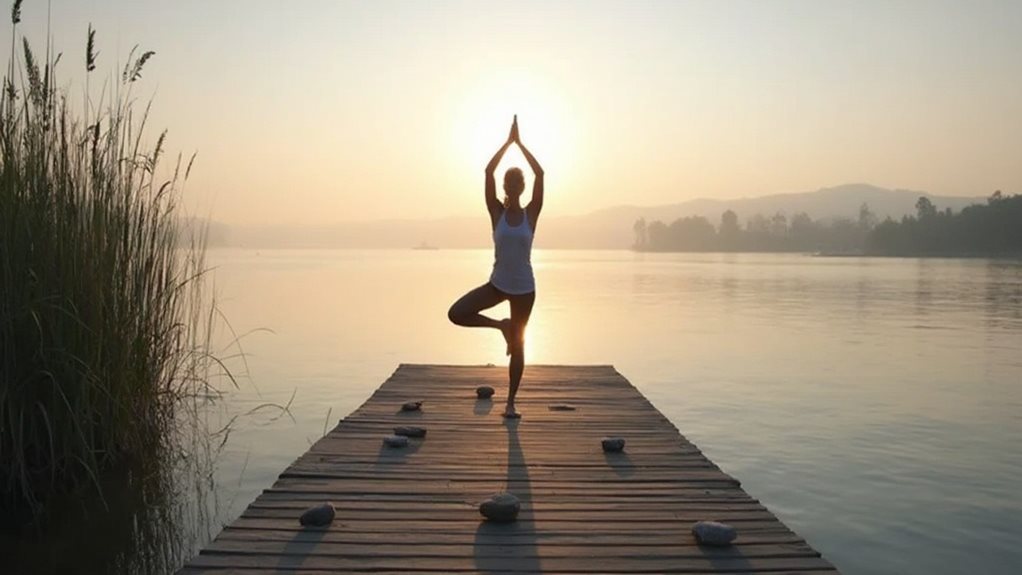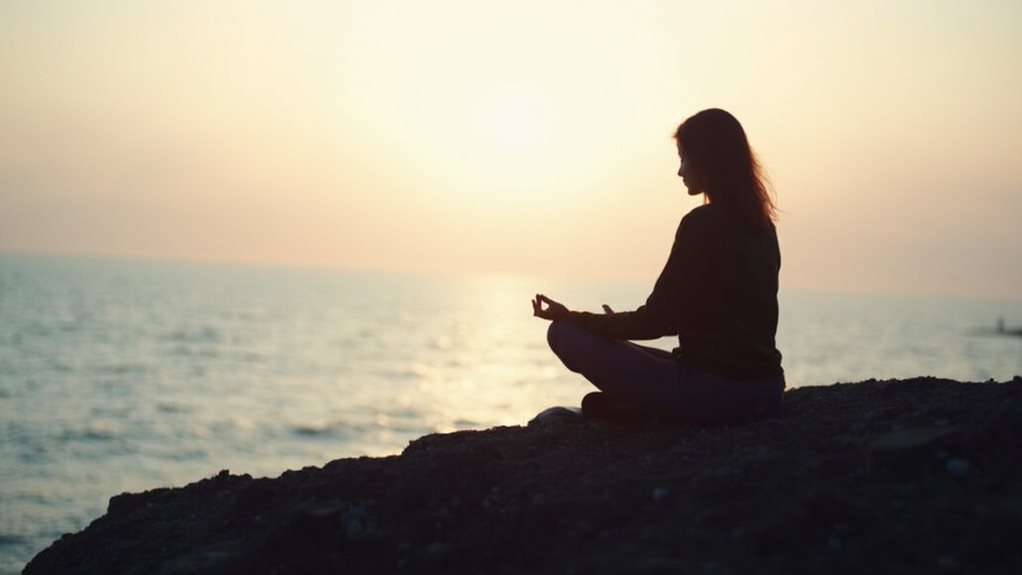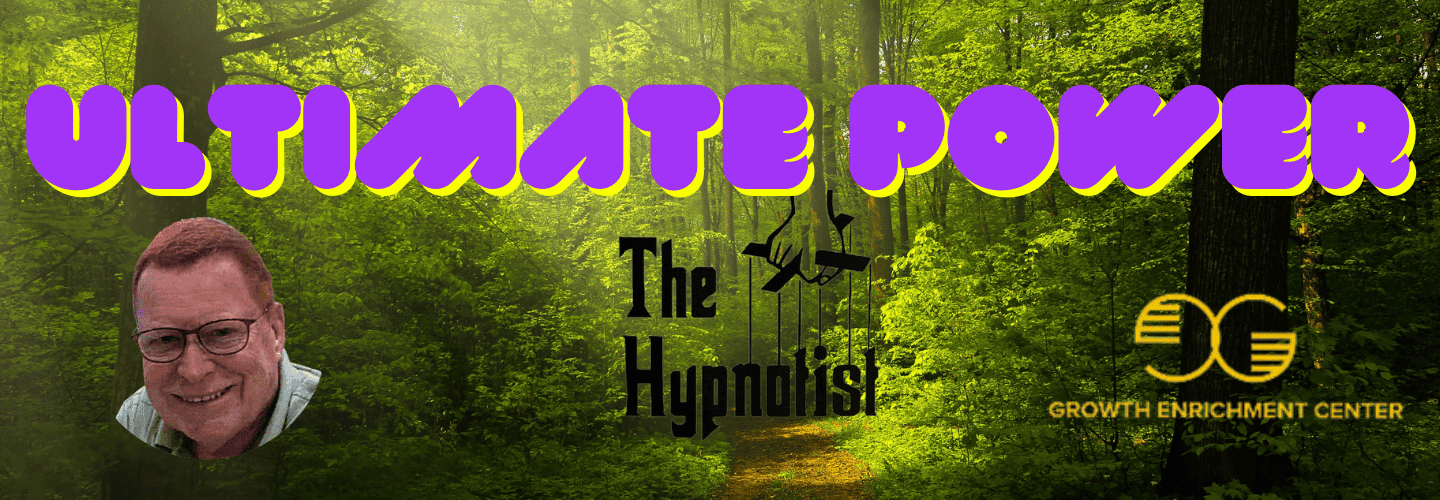
To reveal the secrets of mindful mastery, start by creating a serene environment to ground your thoughts and heighten your sensory awareness—decorate with calming items and engage in activities that foster tranquility. Establish a relaxing bedtime routine, dimming the lights and limiting screens to promote restful sleep. Your meals, too, should be mindful; savor each bite and appreciate the joys of eating. By integrating these practices into your daily life, you'll uncover a deeper connection with yourself and the world, revealing even more insights as you continue on this path.
Key Takeaways
- Cultivate a serene environment with elements like a Mindful Glitter Jar and gentle chimes to foster focus and tranquility.
- Establish a relaxing bedtime routine, including dimming lights and limiting screen time, to improve sleep and readiness for mindfulness.
- Practice mindful eating by focusing on the sensory experiences of meals and paying attention to body cues of hunger and fullness.
- Engage in nature walks, observing the environment closely and practicing walking meditation to enhance mindful awareness.
- Incorporate mindfulness into daily interactions by pausing to breathe, practicing active listening, and responding thoughtfully to foster deeper connections.
Crafting Your Mindful Environment

To craft your mindful environment, start by creating a space that feels serene and welcoming.
Introduce mindful decorations that resonate with tranquility and peace. Consider a Mindful Glitter Jar that softly captures light, creating a visual focus that soothes the mind.
Add sensory elements like a gentle chime; its clear tone can signal the start and end of your mindfulness practice.
Engage with coloring activities that allow you to express creativity while focusing your thoughts.
Establishing a Relaxing Bedtime Routine
Establishing a relaxing bedtime routine can greatly enhance your sleep quality and overall well-being.
Here's how you can create effective bedtime rituals:
- Dim the Lights: About an hour before bed, lower the lighting in your home. This signals to your body it's time to wind down.
- Limit Screen Time: Turn off electronic devices to improve your sleep hygiene and give your mind a break from constant stimulation.
- Engage in Relaxation: Whether it's reading a book, meditating, or gentle stretching, choose activities that soothe your mind.
Exploring Mindful Eating Techniques

Have you ever paused to truly experience your meal, bite by bite? Mindful eating isn't just about tasting food; it's about engaging deeply with the experience.
As you sit down, free from distractions, focus on the sensory appreciation of your meal. Notice the colors, the textures, and how each component complements another.
Chew slowly, letting the mindful flavors unfold and tell their unique stories. Feel the connection between your body's hunger and fullness cues, learning to trust them.
This practice isn't just nourishing for the body—it feeds the soul, enhancing your appreciation for the simple joys of eating.
Engaging in Nature Walks for Enhanced Mindfulness
After embracing the mindful practice of eating, consider stepping outside to further deepen your mindfulness journey. Engaging in nature walks can transform your connection to the world around you through mindful observation and sensory exploration.
Here's how you can enhance your mindfulness during these walks:
- Nature Immersion: Fully immerse yourself, feeling the subtle changes in air and the diverse textures underfoot.
- Seasonal Awareness: Observe the shifting landscape and wildlife patterns, aligning your senses with the rhythm of nature.
- Walking Meditation: Focus on each step, breathing in the tranquility and exhaling stress, cultivating a profound environmental connection.
Embrace these moments of nature appreciation for a rejuvenating experience.
Embracing Yoga and Specialized Mindful Practices

While embracing the tranquility of nature walks has its unique benefits, incorporating yoga and specialized mindful practices can greatly enhance your overall well-being. Yoga benefits both your mind and body, improving flexibility and reducing stress. Meditation techniques like body scan and loving-kindness foster deep relaxation and empathy. Here's a simple guide to get you started:
| Practice | Benefit |
|---|---|
| Yoga | Enhances flexibility and calm |
| Body Scan | Promotes relaxation and awareness |
| Loving-Kindness | Builds empathy and resilience |
You'll find these practices enrich your life, offering peace and balance amidst daily challenges. Remember, it's your journey; embrace it fully.
Discovering Mindfulness Retreat Opportunities
Why not deepen your mindfulness journey by exploring retreat opportunities designed to enhance your mental and emotional well-being?
Retreats offer a unique environment where you can fully immerse yourself in mindfulness practices, away from daily distractions.
Here's what you can expect:
- Structured Programs: Engage in sessions that cultivate peace and clarity.
- Serene Settings: Connect with nature and quiet your mind.
- Community Connection: Meet others on similar paths, fostering mutual support.
Mindfulness benefits are magnified in such settings, making retreat planning an invaluable step in your journey.
Imagine returning rejuvenated, with new insights and a refreshed spirit.
Managing Chronic Pain Through Mindfulness

If you're grappling with chronic pain, embracing mindfulness might transform your approach to discomfort.
Cultivating body awareness through mindfulness allows you to notice and manage pain signals differently. Through mindful reflection, you develop pain acceptance, acknowledging discomfort without resistance.
This fosters emotional resilience by reducing stress and enhancing your ability to cope. By practicing awareness cultivation, you respond to pain with a compassionate response, softening the emotional impact.
Pain management becomes integrated into your life, not as a battle, but as a journey of understanding and gentle care. Embrace this path, and find a more peaceful coexistence with your pain.
Integrating Mindfulness Into Daily Work and Relationships
Integrating mindfulness into your daily work and relationships can greatly enhance your interactions and overall job satisfaction.
By focusing on mindful communication, you'll find emotional resilience blossoming, making you more adept at handling stress and conflicts.
Here's how you can start:
- Pause Regularly: Take brief moments to breathe and center yourself throughout the day.
- Listen Actively: Give your full attention in conversations, fostering deeper connections.
- Respond Thoughtfully: Consider your words carefully, promoting clarity and reducing misunderstandings.
These simple steps can transform your daily interactions, helping you lead a more mindful and fulfilling life at work and home.
Frequently Asked Questions
How Do Mindfulness Techniques Differ for Children Versus Adults?
Mindfulness techniques for children involve playful activities and visual aids, while adult practices focus on deeper self-awareness and structured meditation. You'll find child techniques more engaging and simplified, suited to their developmental stage.
Can Mindfulness Practices Improve Immune System Function?
Yes, embracing mindfulness practices can enhance your immune response. By reducing stress, you boost immune function, reaping mindfulness benefits that keep your body's defenses strong against illness. It's a nurturing, powerful tool for health.
What Are the Best Mindfulness Apps Available for Beginners?
You're starting your mindfulness journey, and finding the right app is key. Compare apps like Headspace and Calm for their beginner-friendly features. Both offer guided sessions that ease you into daily mindfulness practices effectively.
How Does Mindfulness Impact Long-Term Neurological Health?
Mindfulness isn't just a drop in the ocean; it greatly boosts your brain's health. Regular practice enhances neuroplasticity, slows cognitive aging, and supports long-term neurological well-being. You're truly nurturing your mind's resilience.
Is There Scientific Evidence Supporting Mindfulness as a Therapy?
Yes, there's substantial scientific evidence supporting mindfulness as therapy. Mindfulness research consistently shows positive therapeutic outcomes, improving mental health and emotional resilience. You'll find it beneficial in managing stress and enhancing overall well-being.
Conclusion
As you step away from the chaos and into calm, remember that mastering mindfulness isn't about perfection—it's a journey. Every deep breath in nature, every mindful meal, and every reflective moment is a step closer to inner peace. Whether you're easing pain through meditation or weaving mindfulness into your daily interactions, embrace each small victory. Celebrate your progress, knowing that with each mindful step, you are cultivating a life of deeper joy and connection.

